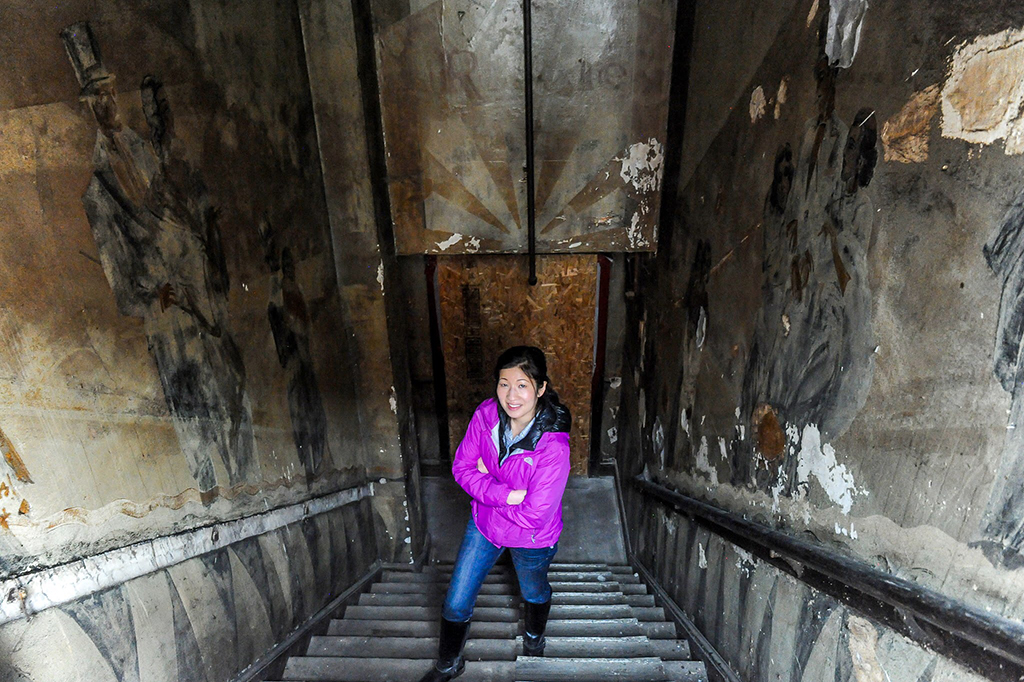By NICOLE BRODEUR
The Seattle Times

Tanya Woo on the Louisa Hotel staircase where old murals line the walls. (Photo provided by Tanya Woo)
SEATTLE (AP) — Tanya Woo used to cry when she started down the basement stairs of the building on King Street, and when you look up, you see why: On a now-faded sign painted on the wall above is a wooden arm that looks to be hanging in midair.
Years later, Woo is happy to linger on those stairs, working to preserve not only the old sign that reads “Club Royale,’’ but a series of Jazz Era murals that line the stairway and cover the walls of the room below.
“We’re learning as we go,’’ Woo said the other morning as we stood on the basement stairway of the building.
The building was once the Hudson Hotel and then the Louisa, where Chinese, Japanese and Filipino immigrants would stay before being shipped off to Alaska to work in fish canneries.
Now, the Woo family is turning the building into 84 new apartments for those making between $45,000 and $75,000 a year, and restoring 10 retail spaces on the street level.
The family has owned the 1910 building since 1963, when Woo’s father, Paul, paid $160,000 for it. That hasn’t always been easy.

Peacock mural (Photo provided by Tanya Woo)
In 1983, the building was the site of the Wah Mee Massacre, in which 14 people were shot — 13 of them killed — in a gambling club. It was Washington state’s deadliest mass shooting.
And in 2013, a Christmas Eve fire damaged seven businesses on the street level, including Sea Garden restaurant and Mon Hei Bakery, which was Chinatown’s first bakery.
Half of the building had to be torn down.
But with the renovation, a new — and welcome — kind of history has emerged.
When workers removed a chute that was used to toss bags of flour to the bakery down below, they found murals along the basement stairway, as well as a button tucked under the railing. (It still buzzes; I tried it.)
The murals — oil paint on plaster with a metal lath backing — depict men and women in formalwear, men in top hats and tuxedos, women draped in fur-trimmed coats. There are two women together; two men together; a man flanked by two women. Most are African Americans in Prohibition attire, but there are white people depicted, which is consistent with the culture of that era.
“They’re all racially ambiguous,’’ Woo said. “It looks like people got really dressed up, and were there to see and be seen. It’s surprising that Chinatown had a place like this.’’
Grady Tripp, who is writing a book about Seattle Prohibition, posted photos of the murals on Reddit and wrote that the club was a “fabled speakeasy’’ officially named The Hong Kong Chinese Society, but known as “The Bucket of Blood’’ — named, Tripp said, for the enormous tin cups in which the beer was served.
One of the servers was Jimi Hendrix’s mother.
At the base of the stairs was a heavy-duty door with a small window slit, where members would slide a special card in order to get in. Tripp wrote that the place was raided and shut down in February 1931 by then-Seattle Police Lt. Frank Olmstead, whose brother, Roy, was a famous bootlegger.
The discovery of the murals has forced changes to the original plans for the renovation, for which 14 percent is being financed by federal historic tax credits. In order to preserve the murals in the stairway, the architect, Bob Hale, has created another stairway on the other side of the building.
In early March, a demolition crew working in the basement discovered the murals, stopped working and, after notifying Woo, covered them with plywood.
Drilling in the basement had to be stopped because it was causing the paint on the stairway murals to peel.
“We went into this not knowing anything about its history,’’ Woo said, adding that she only remembered the bakery and the noodle company in the basement.
Woo is seeking the public’s help in raising the $200,000 needed to save, restore and preserve the murals, and install a pane of glass over the doorway so that the public can view the murals from the sidewalk.
“There’s interest in our shared history,’’ Woo said, “in finding the hidden gems and discovering pieces of our past.’’
She locked the basement door behind us.
“I have spent so much time here. But I don’t get sick of this place.’’



